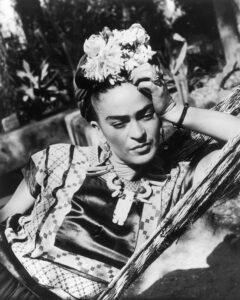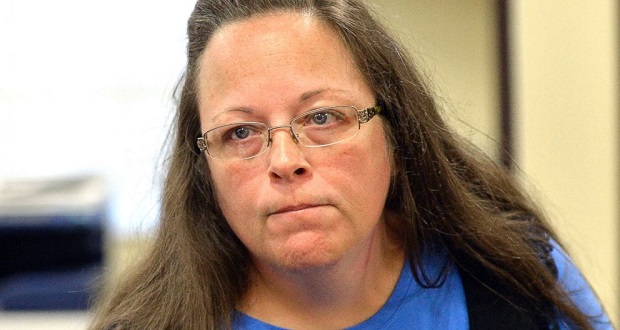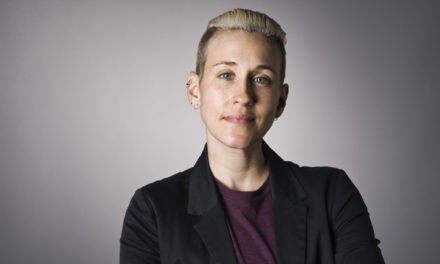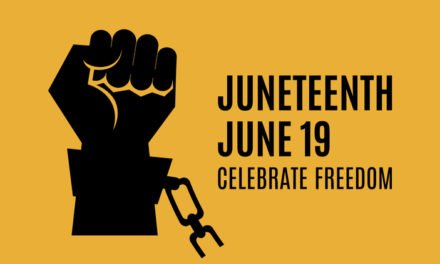
circa 1950: Mexican artist Frida Kahlo (1907 – 1954), wearing a folk costume and flowers in her hair, leans her head on her hand while lying in a hammock. (Photo by Archive Photos/Getty Images)
In the 1980s, Brooke Shields was catapulted into fame for her acting chops, and well, her eyebrows. That’s right. In 1981, Time put a baby-faced Shields on its cover and declared that she was the official representative of the 80s “look.” I think Shields is beautiful and intelligent and talented, but she is hardly the originator of the full brow look. That honor, in my humble opinion, is reserved for someone who lived and contributed over 50 years before that iconic magazine cover was printed. Someone whose eyebrows were the talk of the town in the early to mid-1900s because she was a prolific self-portraitist.
The owner of the magnificent eyebrows I am speaking of, Frida Kahlo, whose birthday is today, was in her lifetime a spectacular artist and, since her passing, has transformed into a true icon. Kahlo’s name is synonymous with cultural pride, courageous feminism, barrier-less sexuality, strength, and perseverance in the face of disability and pain.
Kahlo was once quoted as saying the following: “At the end of the day, we can endure much more than we think we can.” I think there is no truer statement that captures her essence. Endurance. The notion of pushing through, staying the course, even when things get to be unbearable.
Kahlo experienced polio as a child, which left her with a limp, but it was the multiple surgeries she suffered through in 1925, following a bus accident, that were a true testament to her endurance. It is said that she used her recovery time to explore her talent, reading books to educate herself and experimenting with her craft. It was just a few years after the accident that Kahlo would marry Diego Rivera, another famous Mexican painter. Prior to their nuptials, Rivera was known as one of the key figures who encouraged Kahlo’s gift during those formative years[1].
As a woman who was a painting major in college, raised in a home where I was encouraged to be accepting of everyone, Kahlo stood out like a beacon during the years that most shaped me from a teenager into a woman. I distinctly remember a professor of mine in college speaking about Kahlo’s work when we were assigned the task of painting our own portraits. This professor flipped through a presentation of Kahlo’s most known work, as he spoke to the unique kind of bravery required when one has to gaze upon their likeness for any extended period of time. Indeed, it takes a certain personality to explore in a way that is more determinantly self-reflective than judgmental.
Kahlo’s self-portraits were not just a representation of her life, but statements, sentiments, and commentary, intended and otherwise. Two Nudes in a Forest is one of those paintings shown by my professor that is known as an expression of Kahlo’s love for and attraction to both men and women. In her obvious but tasteful handling of her bisexuality, Kahlo became something of a hero for the LGBTQIA+ community; a designation that has stood the test of time.
The allegiance to her culture, as evidenced by her clothing choices and accessories, and even her hair, gave those who are able to appreciate her art a resolute understanding that Kahlo was not just Mexican by birth and anxious to shed such ties for the sake of mobility. Rather, she was, until the time of her passing, proud of her heritage and birthplace. As one report pointed out, “For years, Kahlo even claimed she was born in 1910 so that she would be perceived as a daughter of the revolution.” [2]
Kahlo’s unwillingness to alter her appearance or candor in speaking of the plight and treatment of women in our society has also branded her a champion for all things feminist to this day. In fact, while the young person in a recent Amazon Prime commercial decides to emulate the spirit and appearance of Freddie Mercury, their facial hair, which is arguably the focal point of a physical transformation, brings to mind the famous ‘stache Kahlo unabashedly boasted during her lifetime. The messaging is unquestionably the same: Be yourself, unapologetically, always.
There is often controversy surrounding women who stand out as historical figures, which in itself is evidence of the kind of sexism that proliferates in our Western culture in the United States, and certainly many other places around the globe. These days, it seems as though (and certainly I am not complaining) hashtags are doing the work of spreading this message (#quietwomenrarelymakehistory, #strongwomen, etc.). While that’s wonderful and certainly brings attention to the never-ending fight on the side of equality for women, I think there’s something particularly special about someone who has led by example. Someone who was, in many ways, an inadvertent and unwitting leader.
I’m not sure Kahlo wanted to start a movement (outside of surrealism) or cultivate such a following. Maybe she did? I suppose we won’t really ever know. So, we will just have to swim in the delicious joy of the knowledge that her everlasting mark and influence will forever be felt. It will be felt by all of those who are inspired by her art, her courage, her allegiance, her pride.
This 6th of July, let us raise a glass to toast Kahlo, the queen of the self-portrait, the queen of self-reflection, and the queen of self-expression. May her memory be one that cultivates feelings of empowerment and free expression of self, forever more.
[1] https://www.britannica.com/biography/Frida-Kahlo
[2] https://amp.cnn.com/cnn/style/article/frida-kahlo-birthday-trnd-style/index.html



















